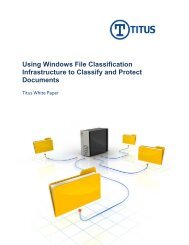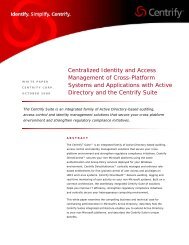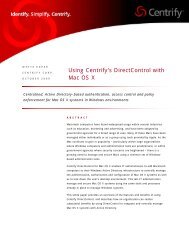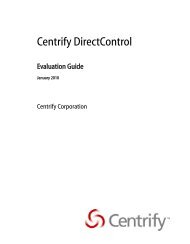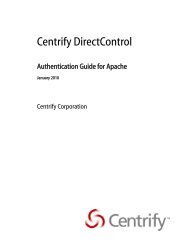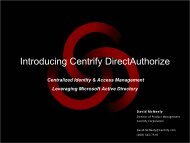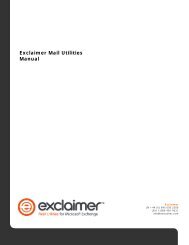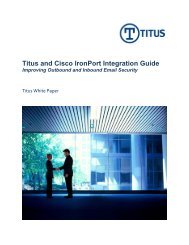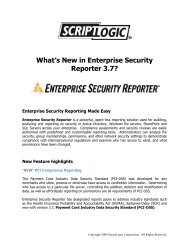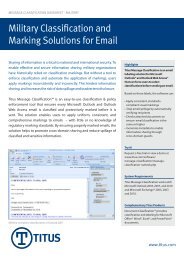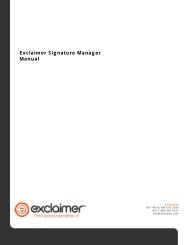Centrify DirectControl Best Practices - Cerberis
Centrify DirectControl Best Practices - Cerberis
Centrify DirectControl Best Practices - Cerberis
You also want an ePaper? Increase the reach of your titles
YUMPU automatically turns print PDFs into web optimized ePapers that Google loves.
CENTRIFY WHITE PAPERCENTRALIZED MANAGEMENT FOR UNIX, LINUX, MAC AND JAVA WITH ACTIVE DIRECTORY AND DIRECTCONTROLof the underlying disks, and, in the case of remote storage (NAS, NFS, etc) the speed ofthe connection. It is a best practice to estimate the time required for adfixid verypessimistically, particularly for purposes of scheduling outage or change windows.Once all users have been migrated to Active Directory and adfixid has been executed,there is no additional benefit to running adfixid again. It is a best practice to keep amaster list of all machines where adfixid has been executed and to require all personnelto update that list once adfixid has been executed.Finally, adfixid has a rollback option that will undo all changes since the beginning of thelog file. By default, the log file is /etc/centrifydc/adfixid.log. It is a best practice to gzipthis log file (thereby manually check-pointing the log) upon the successful completion ofeach UNIX computer. For example, if Clyde Baum runs adfixid against the /var, /tmp,and /home directories on medcalc.illumiclinics.com, he should gzip/etc/centrifydc/adfixid.log once all three mount points have been processed.3.8.3 Solution: removing duplicate users and groupsMultiple auditing and compliance standards require the removal of local users once thoseusers have been migrated to Active Directory. There are three possible methods ofremoving local users and groups from UNIX computers:1. Use the included ‘adrmlocal’ utility that is included with <strong>Centrify</strong> <strong>DirectControl</strong>; or,2. Use the native platform tools for that version of UNIX; or,3. Use a text editor to manually edit the appropriate files.The method of removing local users and groups largely depends upon the migrationstatus of groups to Active Directory.If there no Active Directory Users are defined in local UNIX groups, then use‘adrmlocal’. The adrmlocal utility will leverage the platform-native utilities to remove thelocal users and groups. If the native platform tools make backups of the files beingmodified, then adrmlocal will inherently make backups of those files (it does not,however, make additional backups). adrmlocal does not take additional backups.If there are Active Directory Users defined in local UNIX groups (such as the ‘opsteam’group in Figure 3-3), then manually edit the files. This is because all native platform toolsare greedy when they remove user accounts, removing both the local user account andalso removing that username from all local groups. In cases where a local group has notbeen migrated to Active Directory, the local files must be manually edited.For example, group ‘dba’ has a GID of 10001 and is defined as a local group on dbserver(see section Error! Reference source not found. for details).dba::10001:rcranfil,hgarry,acolliga,enerio,sramnari,tetsu,mysql© CENTRIFY CORPORATION 2004-2007. ALL RIGHTS RESERVED. PAGE 29



